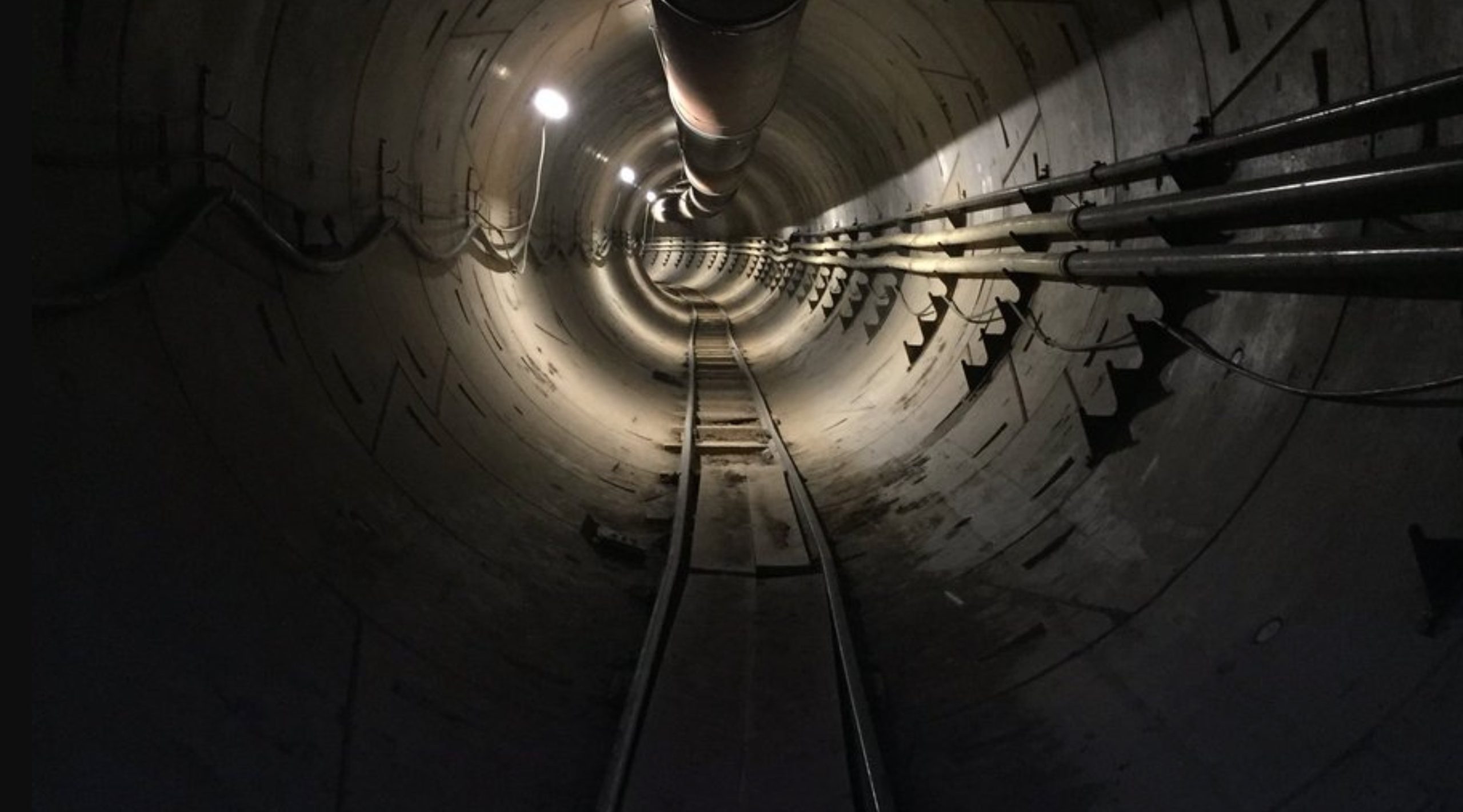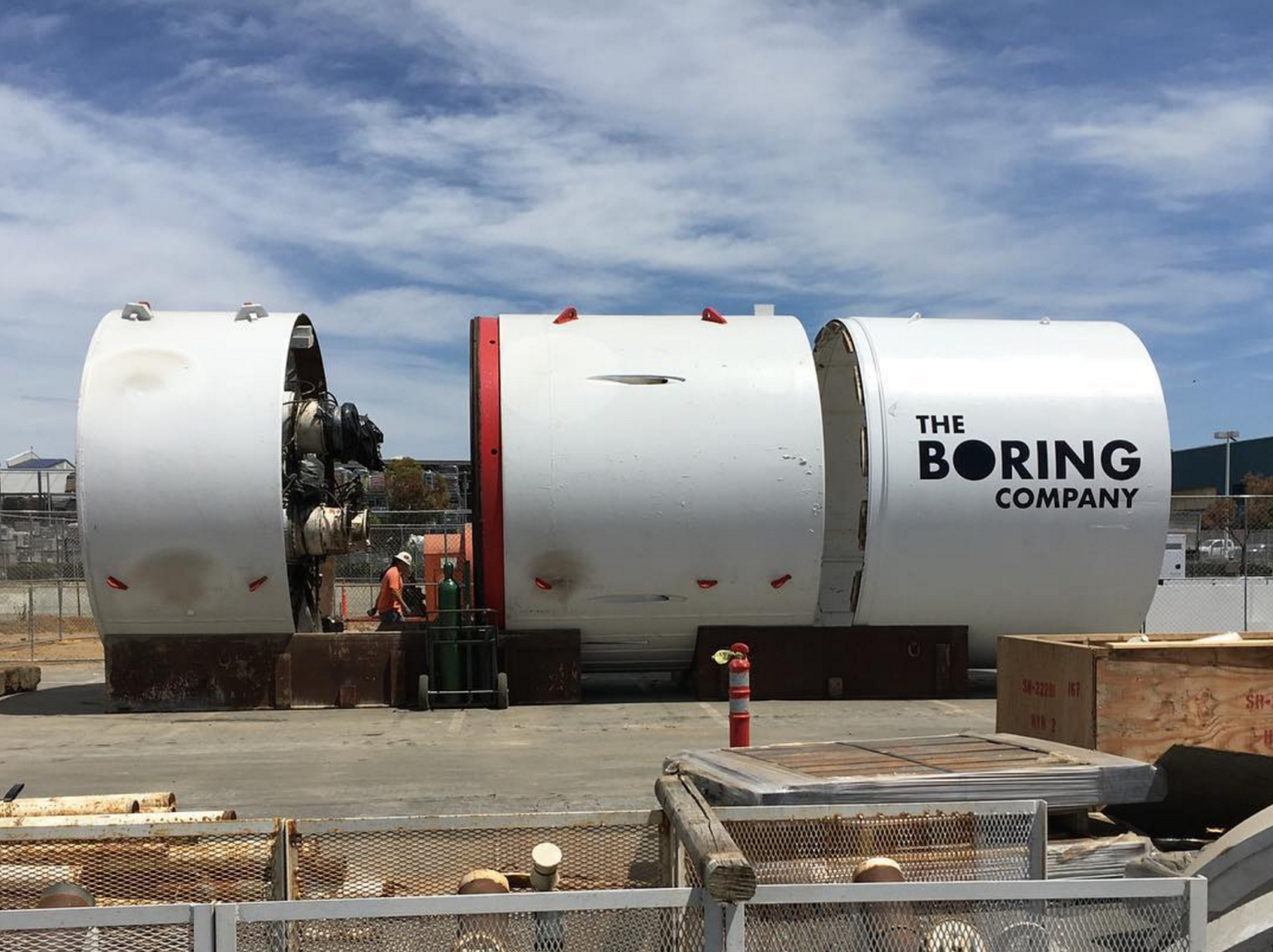

News
Elon Musk’s Boring Co. takes aim at fighting LA traffic
The Boring Company’s test tunnel that adjoins SpaceX and Tesla’s Design Center in Hawthorne, CA is really starting to take shape. Serial tech entrepreneur Elon Musk posted an image on Saturday that shows a long run of track, pipes and reinforcement inside a tunnel. In addition to providing a first look at a 500 feet stretch of The Boring Company’s test tunnel, Musk also revealed plans for the company’s first route that’s expected to begin from LAX airport and run parallel to major Los Angeles corridor, Interstate 405, and north to U.S. Route 101.
It doesn’t come as much of a surprise that Musk would choose this section as the company’s first project. After all, his dealing with constant soul-crushing traffic along a path of travel that’s a consistent winner of “America’s worst freeways” was the genesis for The Boring Company.
“First route will go roughly parallel to the 405 from LAX to 101, with on/offramps every mile or so. It will work like a fast freeway, where electric skates carrying vehicles and people on pods on the main artery travel at up to 150mph, and the skates switch to side tunnels to exit and enter.” says Musk.
Vehicles entering and exiting the tunnels would be helped by a car elevator, something Musk first demonstrated in July after posting a video of a Tesla Model S being lowered into the tunnel entrance. The use of side tunnels for exit and entry will allow the main tunnel to keep a consistent, high speed flow of traffic and make travel more efficient. It’s a key differentiator from traditional subway systems that often experience frequent stop-and-go travel. “There is a big difference compared to subways that stop at every stop, whether you’re getting off or not.” said Musk after sharing an image of the test tunnel.
Picture of The Boring Company LA tunnel taken yesterday pic.twitter.com/TfdVKyXFsJ
— Elon Musk (@elonmusk) October 28, 2017
In addition to the tunnel project taking place in Los Angeles, The Boring Company has recently been given permission by Maryland officials to dig a 10.1-mile tunnel beneath state-owned land that looks to connect Baltimore with Washington, DC. “Incredibly excited to announce our administration’s support for The Boring Company to bring rapid electric transportation technology to Maryland, connecting Baltimore City and Washington D.C.” said Maryland Governor Larry Hogan on October 19 in a Facebook post.
As The Boring Company continues to build its 2-mile test tunnel that’s located a stone’s throw away from LAX, it’s expected that the team will also continue to learn techniques that will allow them to maximize efficiencies with tunnel digging and moving earth. Musk revealed at TED 2017, in a sit-down with head curator Chris Anderson, that The Boring Company plans to cut tunnel diameter by 50% for passenger vehicles and reduce the cross sectional area of tunnels by a factor of four. Building a smaller tunnel that’s just large enough for a vehicle will cut 75% of the time associated with digging and introduce a significant cost reduction.
Unlike traditional tunnel boring machines that dig slowly and incrementally, as it stops so that a team can build tunnel reinforcements, Musk’s GoDot digger looks to install tunnel walls continuously. Being able to build reinforcements into a tunnel while it’s being dug eliminates the need to pause operations, thus speeding up the entire process.
Though Musk’s vision to build a high speed underground transportation system in major cities might face opposition from local regulators at first, visibility of progress being made by The Boring Company in Los Angeles and beyond, and ultimately the cost savings involved with such projects will lead to the eureka moment for government officials worldwide.
Why wait nine years on a $1.5 billion “beach shuttle” when you can do it in less than half the time and at a fraction of the cost? Eureka.

News
Tesla starts showing how FSD will change lives in Europe
Local officials tested the system on narrow country roads and were impressed by FSD’s smooth, human-like driving, with some calling the service a game-changer for everyday life in areas that are far from urban centers.

Tesla has launched Europe’s first public shuttle service using Full Self-Driving (Supervised) in the rural Eifelkreis Bitburg-Prüm region of Germany, demonstrating how the technology can restore independence and mobility for people who struggle with limited transport options.
Local officials tested the system on narrow country roads and were impressed by FSD’s smooth, human-like driving, with some calling the service a game-changer for everyday life in areas that are far from urban centers.
Officials see real impact on rural residents
Arzfeld Mayor Johannes Kuhl and District Administrator Andreas Kruppert personally tested the Tesla shuttle service. This allowed them to see just how well FSD navigated winding lanes and rural roads confidently. Kruppert said, “Autonomous driving sounds like science fiction to many, but we simply see here that it works totally well in rural regions too.” Kuhl, for his part, also noted that FSD “feels like a very experienced driver.”
The pilot complements the area’s “Citizen Bus” program, which provides on-demand rides for elderly residents who can no longer drive themselves. Tesla Europe shared a video of a demonstration of the service, highlighting how FSD gives people their freedom back, even in places where public transport is not as prevalent.
What the Ministry for Economic Affairs and Transport says
Rhineland-Palatinate’s Minister Daniela Schmitt supported the project, praising the collaboration that made this “first of its kind in Europe” possible. As per the ministry, the rural rollout for the service shows FSD’s potential beyond major cities, and it delivers tangible benefits like grocery runs, doctor visits, and social connections for isolated residents.
“Reliable and flexible mobility is especially vital in rural areas. With the launch of a shuttle service using self-driving vehicles (FSD supervised) by Tesla in the Eifelkreis Bitburg-Prüm, an innovative pilot project is now getting underway that complements local community bus services. It is the first project of its kind in Europe.
“The result is a real gain for rural mobility: greater accessibility, more flexibility and tangible benefits for everyday life. A strong signal for innovation, cooperation and future-oriented mobility beyond urban centers,” the ministry wrote in a LinkedIn post.
News
Tesla China quietly posts Robotaxi-related job listing
Tesla China is currently seeking a Low Voltage Electrical Engineer to work on circuit board design for the company’s autonomous vehicles.

Tesla has posted a new job listing in Shanghai explicitly tied to its Robotaxi program, fueling speculation that the company is preparing to launch its dedicated autonomous ride-hailing service in China.
As noted in the listing, Tesla China is currently seeking a Low Voltage Electrical Engineer to work on circuit board design for the company’s autonomous vehicles.
Robotaxi-specific role
The listing, which was shared on social media platform X by industry watcher @tslaming, suggested that Tesla China is looking to fill the role urgently. The job listing itself specifically mentions that the person hired for the role will be working on the Low Voltage Hardware team, which would design the circuit boards that would serve as the nervous system of the Robotaxi.
Key tasks for the role, as indicated in the job listing, include collaboration with PCB layout, firmware, mechanical, program management, and validation teams, among other responsibilities. The role is based in Shanghai.
China Robotaxi launch
China represents a massive potential market for robotaxis, with its dense urban centers and supportive policies in select cities. Tesla has limited permission to roll out FSD in the country, though despite this, its vehicles have been hailed as among the best in the market when it comes to autonomous features. So far, at least, it appears that China supports Tesla’s FSD and Robotaxi rollout.
This was hinted at in November, when Tesla brought the Cybercab to the 8th China International Import Expo (CIIE) in Shanghai, marking the first time that the autonomous two-seater was brought to the Asia-Pacific region. The vehicle, despite not having a release date in China, received a significant amount of interest among the event’s attendees.
Elon Musk
Elon Musk and Tesla AI Director share insights after empty driver seat Robotaxi rides
The executives’ unoccupied tests hint at the rapid progress of Tesla’s unsupervised Robotaxi efforts.

Tesla CEO Elon Musk and AI Director Ashok Elluswamy celebrated Christmas Eve by sharing personal experiences with Robotaxi vehicles that had no safety monitor or occupant in the driver’s seat. Musk described the system’s “perfect driving” around Austin, while Elluswamy posted video from the back seat, calling it “an amazing experience.”
The executives’ unoccupied tests hint at the rapid progress of Tesla’s unsupervised Robotaxi efforts.
Elon and Ashok’s firsthand Robotaxi insights
Prior to Musk and the Tesla AI Director’s posts, sightings of unmanned Teslas navigating public roads were widely shared on social media. One such vehicle was spotted in Austin, Texas, which Elon Musk acknowleged by stating that “Testing is underway with no occupants in the car.”
Based on his Christmas Eve post, Musk seemed to have tested an unmanned Tesla himself. “A Tesla with no safety monitor in the car and me sitting in the passenger seat took me all around Austin on Sunday with perfect driving,” Musk wrote in his post.
Elluswamy responded with a 2-minute video showing himself in the rear of an unmanned Tesla. The video featured the vehicle’s empty front seats, as well as its smooth handling through real-world traffic. He captioned his video with the words, “It’s an amazing experience!”
Towards Unsupervised operations
During an xAI Hackathon earlier this month, Elon Musk mentioned that Tesla owed be removing Safety Monitors from its Robotaxis in Austin in just three weeks. “Unsupervised is pretty much solved at this point. So there will be Tesla Robotaxis operating in Austin with no one in them. Not even anyone in the passenger seat in about three weeks,” he said. Musk echoed similar estimates at the 2025 Annual Shareholder Meeting and the Q3 2025 earnings call.
Considering the insights that were posted Musk and Elluswamy, it does appear that Tesla is working hard towards operating its Robotaxis with no safety monitors. This is quite impressive considering that the service was launched just earlier this year.









